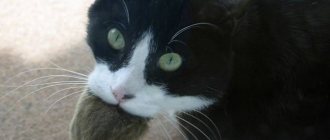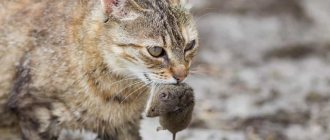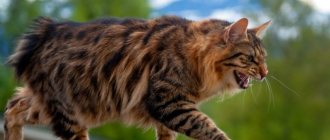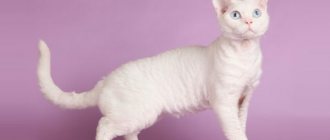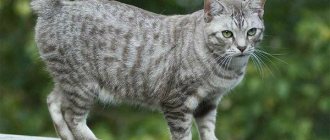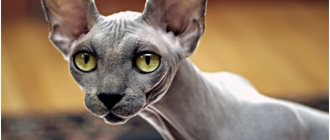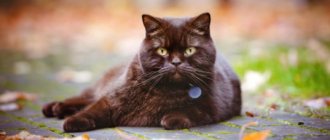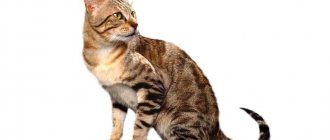In addition to their soft fur and purring, cats have always been famous for their ability to catch rats and mice. The rat catcher is not a breed, but a useful skill that representatives of certain breeds are predisposed to develop. As a rule, these animals do not become attached to their owner, tolerate loneliness well and have excellent health. How can you determine from a description of its appearance and character whether a kitten can catch rats or not?
History of Pied Pipers
The domestication of cats occurred in Egypt approximately 9 thousand years BC. e. In those days, the grain harvested from the fields was eaten by mice and rats. People saw how cats hunted them and began to lure and tame the nimble hunters. Since then, these animals have taken their place next to people, ridding them of rodents. For such merits, cats were called sacred animals, protecting food supplies and saving people from hunger. Since ancient times, cats have been given special honors, and high fines were imposed for killing them. The cost of a clever rat-catcher cat was equal to the cost of an ox.
Agile rat-catching cats in the old days were worth as much as an ox
There is a legend that says that during the global flood, rodents appeared on Noah’s Ark, dangerous to the inhabitants. Then cats were born from the lions, destroying all the rodents and saving the animals on the ship from them.
Cats conscientiously performed their duties in peasant homes, in monasteries, and at the royal court. Peter I ordered the adoption of cats to protect barns from the invasion of mice and rats. By order of Elizabeth, his daughter, 30 rat-catcher cats were brought to the Winter Palace from Kazan, the city where the most dexterous rat-catchers were believed to live. During the reign of Catherine II, cats appeared in the Hermitage to protect works of art from rodents.
During the siege of Leningrad, cats saved residents and the city itself 2 times. When, in the first years of the siege, all the animals were eaten due to hunger, many rodents appeared in the city, and the Winter Palace was simply swarming with them. To combat dangerous rodents, 5 thousand smoky cats were brought from Yaroslavl to Leningrad in April 1943, then a train of Siberian cats arrived, and soon rodents disappeared from the city.
Cats still regularly serve in the Hermitage, protecting the country’s cultural heritage from rodents and forming an integral part of museum life; they are its unique symbol. Museum employees say that throwing cats out into the street is like throwing a painting by an outstanding artist from the 10th floor.
Cats in the Hermitage protect the country's cultural heritage from rodents
Mice in the diet - harm or benefit
Rodents are as beneficial as they are harmful to cats, at least according to veterinarians who are concerned about the “bouquet” of diseases transmitted by the former. It is believed that mice (like rats) are carriers of infectious diseases that are dangerous both for the pets themselves and for their owners.
The list of such diseases includes:
- trichinosis - difficult to treat and caused by helminths that parasitize the intestines (larvae penetrate muscle tissue and destroy it);
- ringworm (ringworm) is a fungal infection that affects the appearance of the coat/skin. The therapy is simple but long-lasting;
- leptospirosis - affects various organs and is accompanied by fever. A cat becomes infected through contaminated water, eating mice or coming into contact with their secretions;
- toxoplasmosis is dangerous for pregnant women and is often asymptomatic. About 50% of rodents are considered carriers of the disease;
- salmonellosis is an acute intestinal infection that threatens humans and animals;
- tularemia, pseudotuberculosis and others.
Hypothetically, a cat that eats mice could become infected with rabies, but this probability is reduced to zero if the animal is vaccinated. The second thing that should reassure the owner is that the virus is transmitted through saliva, that is, the mouse must injure the cat.
Important! Those who live in private homes and keep rat-catching cats say that their animals hunt rat mice for many years, avoiding any infectious diseases. Several generations of cats live to a ripe old age, enriching their daily diet with rodents without tragic consequences for health.
A cat is more likely to be poisoned if it tastes a mouse that has died from the poison used in deratization. If the poisoning is mild, you can get by with pharmaceutical absorbents; in case of severe poisoning (vomiting, diarrhea with blood, liver/kidney failure), call a doctor immediately. Also, when in close contact with rodents, pampered domestic cats often pick up fleas or helminths.
The Siberian cat is an obstinate hunter
Nothing is known exactly about the origin of this breed; most likely, it was brought to Russia from Asia. She was nicknamed “Siberian” for her traditional long and fluffy fur. The cat, as you see in the photo, stands out for its strong build (females grow up to 5-7 kg, and males up to 9 kg) and powerful strong paws with excellent grip. In addition, the hind legs are slightly longer, which allows them to jump and run well.
The Siberian beauty has an obstinate character, excellent speed and reaction, which makes her an excellent hunter. Looking at her, you immediately understand that the cat has more than once participated in skirmishes with rodents. The animal is not very attached to humans, walks on its own and values freedom. By the way, to keep fit, your cat needs regular walks in the fresh air.
The only thing known about the origin of the breed is that it was brought from Asia to Russia. The breed got its name due to its fluffy and long coat. Some owners get these animals just for their attractive appearance. However, not everyone knows that this breed is a born rat catcher.
The appearance is characteristic: representatives of the breed have a strong body (the weight of males reaches 9 kg, and females - 7 kg) and strong legs with a strong grip. The hind legs of these animals are longer than the front ones, due to which they are able to develop greater speed in running and also jump well. Siberian cats have excellent reactions. Even from their glance it is clear that they are able to take part in the fight against mice and rats.
The character of these animals is quite obstinate. They do not become very attached to their owner, preferring to walk on their own. Their freedom is very important to these animals. Due to its free-spirited nature, such a cat needs periodic walks outside.
Cat or cat: who is the better hunter?
If we talk about the gender of mousecatchers, it still seems more reasonable to give the palm to the cat. In cats, the sexual instinct comes first, and if the animal is not castrated, the mustachioed cat can be distracted by “love” all year round, neglecting his hunting duties. We have all seen how skinny and tattered the tailed gentlemen return from their sexual adventures - it is obvious that they had no time for mice.
In cats, the estrus period is usually not long. And, raising kittens, as we said above, they hunt with double zeal and teach their offspring to do so. That is, they have double motivation. And female creatures usually have more persistence and diligence.
General features of rat catchers
The rat catcher is not a separate breed of cat, it is the valuable quality of the animal, the sharpness of its hunting instinct. According to felinologists (specialists in breeding cats), rat-catching cats can be identified by the following characteristics:
- muscular body, powerful jaws, strong legs;
- head shape - there is a relationship between the genes responsible for the instincts of hunters and the genes that determine the configuration of the skull of cats: rat-catching abilities are observed in animals with a triangular head (oriental type of cats);
- lush mustache and high ears with tassels at the ends: they allow animals to detect possible rustles, and this is very important for a successful hunt.
Ratcatcher cats usually have large ears that can detect the smallest noises.
Some rat hunters may be affectionate in nature, while others may be unsociable. There are animals that want to please their owner and often catch rats to show him their love. And there are cats that avoid people and do not welcome affection, but this is also quite normal.
By what signs can you recognize a rat catcher?
A mousetrap cat is not a breed, but a rare skill that a pet develops due to the conditions of its keeping and upbringing. The best hunters are considered to be mongrel cats, who have had to hunt mice for food since childhood.
Street animals are not spoiled by the attention and care of the owner, so the hunting instinct develops and remains for the maximum period
The following signs will help you recognize a future rat catcher in a kitten:
- if one of the parents is good at catching mice, by four months the skill will be transferred to the kitten;
- female. Cats catch mice better than cats, which is associated with increased activity and fearlessness. To feed her offspring, the mother cat will get food in any way, so her hunting instinct is heightened;
- head shape. Animals with a triangular oriental skull shape have greater potential for catching rats;
- activity in the game. If a kitten runs after ribbons, toy mice and catches them with his teeth, he will make a good hunter;
- physiological characteristics. The pet must be well built, have developed muscles, strong bones;
- high ears with tassels. Allow the pet to track rustles and squeaks, which increases the likelihood of finding a target;
- color feature. It is believed that the best hunters are tri-colored, tortoiseshell, and motley cats.
The listed signs increase the likelihood of a successful hunt. But the development of the skill depends on the conditions of detention and upbringing. If you keep your pet in an apartment and give it food when called, the hunting instinct will “die out.”
Maine Coon - the terror of all rats
The Maine Coon cat is a strong and agile breed that is resistant to various conditions, so it can live in areas with harsh climates. The cat is stately and large (the male grows up to 15 kg), has a predatory disposition and does not like affection from humans. Due to its size, it easily copes with rodents, so most often it is used by farmers whose farms are threatened by rats and mice. Maine Coons were originally developed as “working cats.”
The true king of the Maine Coon has a long and dense coat of predominantly dark shades (the photo shows the 3 most common colors), well-developed muscles, strong bones and a wide chest. A distinctive feature of the breed is its peculiar, erect, large ears with tassels. The tail is long and thick with flowing hair. All this makes the cat a threat to all rats and mice.
Questions about breeds and external characteristics.
As has already been noted, the best mousecatchers are cats raised in appropriate conditions.
Although some experts insist that there are still breeds of mousecatchers. These are all European cats with short hair. In this category, the following are distinguished by color:
- European tabby. Outwardly, it resembles a small tiger. Cats of this breed are very strong and stocky. They don't just catch mice, they ruthlessly destroy them.
- European speckled. These are good mouse hunters of various parameters. They also catch lizards, snakes, small birds and fish.
shutterstock
Breeds of rat-catching cats
There are certain breeds in the cat family, whose representatives are distinguished by excellent health, special dexterity and dexterity in catching rats.
Siberian cat
The cat was named Siberian due to its fluffy long hair. She is unpretentious, has a strong build, the weight of cats reaches 7 kg, cats weigh about 9 kg. She has strong paws and excellent grip. Due to the slightly longer hind legs compared to the front legs, the cat has the ability to run and jump quickly. Such animals are obstinate in nature, they have an excellent reaction, which is necessary when catching rats. They are independent and love freedom.
The Siberian cat has a strong build and excellent grip.
To maintain the desired shape, Siberian cats require regular walks in the fresh air.
Maine Coon
Cats of this breed are distinguished by mobility and strength. Maine Coons are hardy and able to live in regions with harsh climatic conditions. These large animals (males can weigh up to 15 kg) have the nature of a predator; they do not welcome human affection. Due to their size, they can easily deal with rats.
Maine Coons easily deal with rats
This breed of cat is distinguished by straight-set large ears, which have tassels at the ends. Maine Coons have long and thick fur. They have well-developed muscles, a wide chest, strong bones, and a thick and long tail. All this data allows Maine Coons to become a real threat to rodents.
Kurilian Bobtail
A feature of animals of this breed is a short tail, the length of which does not exceed 3–8 cm. But they have strong hind legs, which are longer than the forelimbs. And therefore the Kurilian bobtail runs well, jumps, and deftly strangles rats. Males of this breed weigh about 10 kg, females - 6 kg.
The Kurilian Bobtail is fearless and deftly strangles rats
Such cats are capable of completely destroying a mouse or rat hole. They are easy to train and can be trained. People keep them as companions; they get along easily with other animals. Bobtails have a fearless character.
European shorthair cat
Representatives of this breed destroyed rodents back in the days of Ancient Rome. European shorthair cats are called yard cats and are not considered purebred. However, they are popular in the world and are one of the best rat catchers. The predator's passion and agility help them successfully hunt rats and mice.
European shorthair cats are some of the best rat catchers.
Such cats are distinguished by individuality, independence, grace, and aristocratic appearance. They have a short coat, gray or silver marbled in color.
European cats get along well with people and are non-aggressive. They love to play, but do not completely obey their owner.
Cymric
Animals of this breed are similar to ordinary cats, but with a short tail. This structure, along with agility and tenacious claws, makes the Cymric a successful rat catcher.
Agility and tenacious claws make the Cymric a successful rat catcher.
It is good to keep these cats in private homes with open areas, as the animals require regular walks in the fresh air, freedom of movement, and physical activity.
British Shorthair
The hunting instinct and excellent natural inclinations make the British excellent rat catchers. Such cats are calm, friendly, and attractive in appearance. They love to please their owner by bringing him a caught rodent in their teeth in order to exchange it for rewards and something tasty.
Natural inclinations and hunting instinct make British Shorthairs excellent rodent catchers.
Females, weighing an average of 4 kg, try not to attack large rats, hunting only young ones or mice. Often this is enough to avoid a rodent infestation.
Russian blue
Russian blue cats are medium in size and light in weight, but this does not interfere with their hunting habits. Instant reaction and silent movement for a long time make these cats good rat catchers.
The Russian Blue cat has the ability to move silently and react instantly.
The ability of the Russian Blue to react to rodents is a true art: its speed of attack on the prey, accuracy and grace of movements are captivating. This is a thunderstorm of super rats, weighing about 500 g. The Russian Blue does not like partners of other cat breeds, but gets along well with rat catchers of its own breed. Opponent of tenderness from the owner.
Is it possible to stop eating mice?
Modern cats (with the exception of those who sit on pasture) have stopped eating caught mice: they are brought to their owners as proof of their dexterity and diligence, often in gratitude for human care. In addition, a cat will not eat a mouse if it has had enough to eat. If you don’t want your pet to eat rodents, watch the energy value of its usual food.
There is an option - to put on a collar with tiny bells: this way, the cat will not only not eat, but, above all, will not catch the mouse . A side effect is the annoying rattling of the bell, which not everyone can withstand. If your cat starts chasing mice at your dacha, build her an enclosure where she can frolic until the evening: in this case, all the day’s prey will remain in the enclosure, and you will take the cat into the house in the evening. This method is also not flawless - most personal plots are not designed for unplanned structures.
This is interesting! The most ingenious development is considered to be the development of one meticulous programmer, who came up with a compact automatic door for his cat named Squirrel. The guy got tired of bumping into cat trophies (strangled mice/birds in different corners of the apartment) and he designed a door that opened in front of the “empty” cat and did not open if he was holding something in his teeth.
The programmer taught the camera standing at the entrance to analyze the image (which was simultaneously broadcast to the web server), comparing it with a template, and make a decision about allowing the object into the house.
It will also be interesting:
Read also: Why don't you listen to me?
Those who are far from the world of computer technology can cope with the problem in a radical, albeit not entirely humane way, by once and for all banning their cat from going out into the yard.
What cats catch mice and rats
Many owners living in the private sector are specifically looking for mousecatchers. However, identifying them is not always easy. Some rely on genetics. In other words, if the mother was a mousetrap cat, then the kitten will inherit her gift. Another option is breed.
Mousecats are especially needed in private homes
There is no doubt that certain members of the cat family have a greater propensity for catching rats or mice. However, there are other ways to determine which cats are better at catching rats and mice.
How to identify a rat-catcher cat
The first thing you should pay attention to is the color of the animal. Representatives with gray, black, brown, or red skin blend better with nature and, as a result, are more successful hunters. White, unfortunately, in this case, is the most losing.
The second point is education. It is very important how the kitten behaved in childhood. Outdoor games with a bow, a ball, chasing the light of a laser pointer - all this is the preparation and development of hunting instincts.
For your information! Yard cats and female cats are excellent mousecatchers. The point is also that they develop their instincts from childhood. Hunting for them is a way to survive.
An equally interesting question is whether the rat-catcher cat will continue to hunt after castration. The animal's behavior changes after this operation, but this does not mean that it will lose its innate and developed instincts. The only thing you should be careful of in this situation is overfeeding your pet. Such measures often lead to obesity, and, as a result, hunting skills decrease. Therefore, a neutered cat should be given a special diet, so that he will continue to perform the task assigned to him.
Character and behavior of lop-eared animals
The Scotsman is a purebred cat that is distinguished by its kind disposition. Distinctive behavioral traits:
- communication skills and sociability;
- love for children;
- gaiety;
- easy to educate with the right and friendly approach;
- actually cannot be trained;
- playful;
- not mischievous;
- they quickly forget bad things and do not take revenge.
Scottish Folds are an ideal option when there are other animals and children in the house. Such kittens are real aristocrats with their mannerisms and waywardness. Their restiveness and capriciousness are often observed. If the Scots want something, they will definitely achieve it. An adventurous breed with a curiosity for the unknown. When new people appear on their territory, Scottish cats are not very friendly, but then they begin to communicate. Scots love to play, but are not particularly happy with cuddling and cuddling.
Features of care and maintenance
A real rat catcher can be raised from a small kitten. You just need to use some tips:
- To maintain the hunting instinct, the animal should be given food in small portions at least 5-6 times a day. To prevent the cat from becoming lazy, it should not be overfed. Food should not be in the bowl all the time, but the cat should not be left hungry either, since the rat hunter will need strength to attack the rodents.
- It is necessary to cultivate a hunting sense in the future rat catcher, praise and encourage him for any prey he catches: a bird, a mouse, a fly.
- It is difficult for a person to raise a kitten to be a rodent hunter, and therefore there is no need to separate it from its mother cat for up to 5 months so that during this time she can teach him the necessary skills.
- The pet must lead an active lifestyle; it requires not only toys in the form of balls, mice, bows, but also special play complexes.
The gaming complex will help your pet maintain an active lifestyle
- Rat catchers need to be vaccinated against rabies to boost their immunity, since rats are aggressive animals. When cats receive wounds from rodents, the damaged areas must be carefully treated and consulted with a veterinarian.
Otherwise, the care and maintenance of rat catchers is no different from the care of ordinary cats.
Behavior change
There are often cases when cats behave quite aggressively towards household members and guests. Pets are capable of not only scratching furniture, but also attacking. The animal experiences a kind of stress (usually due to dissatisfaction). This behavior goes from episodic to permanent status, since the pet considers it the norm.
The problem can be solved if the animal is sterilized in a timely manner. The cat becomes more accommodating as the source of “indignation” ceases to be relevant
If even several months after the operation the cat still continues to be mischievous, then the cause should be sought in other factors (constant stress, illness, lack of attention, etc.). In the first days after the operation, the animal may behave too calmly
It will seem that in such a short period of time the pet's activity will decrease significantly. But actually it is not. The rehabilitation period for each individual is different. For some, a couple of days are enough to recover, while for others it takes up to several weeks or even months.
The main thing is to provide your pet with complete care. This applies not only to nutrition, but also to attention. After all, the animal needs the support of its owner more than ever.
It is important to find that “golden” mean that will be optimal for creating a postoperative environment for a cat
How to choose the right cat
Oddly enough, non-pedigreed animals that have lived on the street for some time are best suited for the role of a rat trap. The experience they gain brings invaluable benefits in hunting rodents. Such cats know how to get their own food, have the proper “fighting” skills and hardening. Catching rats is one of the basic components in their survival. This refers to animals that were born and raised on the street, and not those that ended up there after a long life in the house.
If you do not want to adopt a cat from the street, then it is worth remembering that a “rat trap” is not a specific breed. If desired, almost any cat can be raised to become a rodent hunter. Still, there are cat breeds that cope with this role better than others. These include:
- Maine Coon;
- Siberian cat;
- Cymric;
- Kurilian Bobtail;
- Siamese cat;
- European;
- Siberian;
- Russian Blue;
- British Shorthair.
Time has shown that these are the breeds that hunt pests most effectively. When choosing the right cat, you should also pay attention to a number of the following factors.
The animal's build must be large. When hunting, a cat will need developed muscles and physical strength. Low stature is another important point. It will allow the rat trap to be more compact and agile.
Another sign of an excellent rodent hunter is the triangular structure of the skull. To more accurately determine the shape of the skull, simply press the animal’s ears to its head. When choosing a rat-catcher cat, it is better to give preference to the triangular structure of the skull.
It has been proven that the hunting skills of females are superior to those of cats. This is due to the cat’s lifestyle: she needs to protect her offspring, feed them and teach them how to get food. This is why you should choose a cat if you want to achieve maximum efficiency.
If you are going to raise a ratcatcher from a kitten, pay attention to how she plays with a toy mouse. Real hunters try to use their teeth and gnaw their prey rather than roll it with their paws.
By what external signs can one identify a future mousetrap?
It is believed that a cat that can successfully catch mice must look the part. What signs can be used to determine which kitten will be an excellent rodent exterminator?
Signs of a mousecatcher:
- long mustache;
- wild color - black, red or gray, two or three colors, with faint stripes and spots to blend with nature and remain invisible to its prey;
- short hair – long and thick guard hair when wet acquires an unpleasant odor, which can scare away the rodent;
- large ears and triangular head;
- large paws.
They tried to choose the best rat catcher using these signs several decades ago. In reality, there are no perfect rat hunters. Every cat has a hunting instinct from birth, but not all representatives of the feline family realize it with equal success.
Before you take a kitten into your home to catch mice, you should ask whether its mother was a good hunter. When raising their cubs, cats pass on their skills to them, including in catching rodents.
If the pet was taken from the street, it is highly likely that its hunting skills will be well developed. In purebred pets, the instinct is dulled, especially if several generations of animals have lived in apartments and do not even know what a mouse or rat looks like.
Is it possible to teach a cat to hunt if she doesn't show much desire to catch mice? In order for the animal’s natural instincts to awaken, it is necessary to let the pet feel a slight feeling of hunger. A cat should not be completely deprived of food - this is cruel and fraught with health problems. You just need to reduce the portion size: malnutrition will awaken the instinct in your pet. After the first successful hunt, it is advisable to reward the animal.
You need to teach your pet to hunt from childhood. There is no point in training an adult castrated cat. The purpose of its existence is food and sleep, such animals become lazy and quickly gain excess weight, and it becomes more and more difficult for them to run every year. But you can and should awaken a kitten’s interest in hunting. To do this, catch the mouse using a mousetrap and let your child play with it while it is still alive.
To activate the kitten's hunting instinct, you should play with it more often using a laser pointer or special toys. If your pet tirelessly chases them, he will become a professional in catching mice.
Ratcatcher cats for rent: where to find, cost
Buying a real rat catcher is quite difficult: you can be deceived for a lot of money. However, in some cities it is possible to rent a cat. You should know that ratcatcher cats are available for rent from breeders, many specialized nurseries, and animal and pet supply stores. After the rats are killed, the animal is returned.
For a cat, being in a new place with unfamiliar people can be stressful, so you cannot be sure that in such an environment he will catch rodents.
You can rent a ratcatcher cat
For this purpose, you can find a rat-catcher cat via the Internet, using message boards, for example, the site for finding part-time jobs YouDo, or specialized forums. There is no fixed price for such services; sometimes it is set depending on the cost of the cat itself. Typically, the price of such a service varies from 500 to 3 thousand rubles.
Forum participants generally have a negative attitude towards giving their animal to catch rats, since no one wants to create a stressful environment for the cat, and besides, this can be dangerous: the rats may already be poisoned.
Popular questions:
If a mouse ate poison and a cat ate a poisoned mouse, is it dangerous for her?
In most cases, nothing bad will happen to the cat, since the mouse is small in size and the concentration of poison will not be high. For a cat to get poisoned from a mouse, it needs to eat several mice at the same time. Poisons containing rodenticides are dangerous for cats. It can have a fairly strong toxic effect on the animal, even in minimal quantities.
If you see that your cat is sick, not feeling well, and you understand that she could have caught and eaten a poisoned rodent, take her to the vet. If there are mice and cats in the house, do not use poison to kill rodents, but use mechanical traps.
What is the effect of using peppermint against mice, and is it safe for a cat?
Some people use peppermint essential oil to repel rodents and prevent cats from preying on them. In recent years, some experts have expressed concern that essential oils have toxic effects on cats.
Unfortunately, I couldn’t find any research on this topic, so decide for yourself. In any case, the effectiveness of this method of controlling rodents is questionable, since essential oils quickly evaporate and cease to be effective.
Are ultrasonic mouse repellers safe for cats?
In 99% of cases they are safe and cats do not pay attention to them, although after a while rodents also get used to them and stop being afraid.
If you decide to use them, just pay attention to the behavior of your pet; if he does not react to them in any way, then use them calmly.
Can a cat become infected with something from eating a mouse?
Kuril defender
The famous Kurilian Bobtails, despite their rather cute appearance, are excellent rat-catching cats. They are aggressive towards attackers, capable of repelling even the invasion of dogs into the territory they protect, and they deal mercilessly with rodents. Bobtails also love plenty of space to play around. In addition, they are well trained and are not at all afraid of water.
The breeds of cats that are good rat catchers also include the Kurilian Bobtail. The bobtail cat first appeared in Russia in the 20th century, when it was brought from the Kuril Islands. These animals are distinguished by their loyal nature to humans. In some ways they even resemble dogs in character.
Kurilian bobtail kittens immediately become attached to a person and try in every possible way to protect him from all sorts of troubles. The latter include rodents. By the way, in addition to mice and rats, bobtails are capable of driving away small dogs that have encroached on their territory.
The breed is distinguished by a small tail, the maximum size of which is only 8 cm. In body structure, these animals resemble a lynx: they have long and powerful hind limbs, allowing them to make excellent jumps. Kurilian bobtails are capable of running at high speed and crushing mice and rats.
The weight of these animals is up to 6 kg in females and up to 10 kg in males. Whatever the hole is - a mouse or a rat, the Kurilian Bobtail can cope with it; it is not without reason that they are often found on farms and in houses where rodent pests predominate.
There have also been cases of cats predicting earthquakes and gas leaks. The Kurilian Bobtail has the character of a warrior: bold and daring.
The peculiarity of the breed is its short tail, which grows only 3-8 cm in length. In return, the animal has limbs of a special structure: the hind legs are always more powerful and longer than the front ones, thanks to which the “domestic lynx” jumps well, runs quickly and crushes rats with ease. The color of a cat can be very different, with the exception of white, lilac and chocolate shades. Weight reaches 10 kg in males and 6 kg in females. The expert will tell you more about the breed in the next video.
We invite you to familiarize yourself with: Mating of British breed cats: how long they go during pregnancy, childbirth || Rules for breeding cats of the British breed
Bobtails can destroy entire mouse and rat holes, so they are most often kept outside the city, on farms and in other places where there are problems with rodents. These cats are trainable and amenable to training, so they do not cause problems for their owners. Companion cats easily find language with both humans and other pets.
Potential Hazards
Is it safe for a cat to indulge in hunting? Not as much as you would like.
Rats, often the prey of cats, are carriers of diseases such as rabies and distemper; they can also be intermediate hosts of fleas and ticks, which are often carriers of piroplasmosis and encephalitis. Birds often carry subcutaneous mites and fungal infections. In addition, street animals can “give” worms to your pet. In cities, rodents are periodically poisoned with rat poison, which, when it enters the cat’s body, kills it.
Owners have phobias of rodents and birds. Phobias should not be confused with fears. The former make a person lose control of himself and cause many unpleasant emotions and problems. If the owner has such deviations, the cat that brought a “gift” into the house may be given to someone else or even thrown out into the street.
There are, of course, indirect dangers. On the street, a cat can be hit by a car, chewed by a dog or another cat, or a pet can run into evil people. The latter is especially true if the cat decides to plunder someone’s chicken coop.
Abyssinian cat
Abyssinian cats are the oldest representatives of the domestic cat family. They were depicted in ancient Egypt on frescoes and even made into statues. For a long time, scientists argued that Abyssinian cats formed in Abyssinia (Ethiopia). However, recent research has shown that the breed may have come from Southeast Asia.
Abyssinian cats have a very capricious character. They are curious and demanding, so they are ready to explore every corner where they live. “Abyssinians” will not let anyone near them if they are dissatisfied with something. However, they appreciate affection and love to talk.
Thanks to its large ears, the breed is considered one of the best rat catchers. “Abyssinians” are very energetic and are always ready to spend their reserves of strength. They often direct their activity towards hunting.
Principles of healthy eating
Biologists and doctors know that any amino acid performs two related functions - it supplies building material to protein chains and supplies the body with energy. Animals often need amino acids from outside, since they are not able to produce them themselves. Such amino acids are called essential. In cats, this is taurine - it is not produced in the body, but is responsible for the performance of its main organs.
Zoologists have found that the highest concentration of taurine is found in the retina of a cat's eye (100 times more than in the blood). This is why taurine deficiency primarily affects vision: the retina degenerates, and the animal quickly and irreversibly goes blind.
In addition, taurine takes care of the heart muscle, where it accounts for half of all free amino acids. Taurine regulates the transport (from and inside the cell) of calcium ions, facilitating heart contractions. A lack of amino acids immediately affects the activity of the cardiovascular system, causing such a terrible disease as dilated cardiomyopathy.
Important! Whatever your cat’s diet (natural or made from industrial food), the main thing you must ensure is the presence of taurine in it.
Taurine, recognized as an effective antioxidant, has a number of additional, but no less important tasks:
- regulation of the nervous system;
- formation of active immunity;
- normalization of blood clotting;
- maintaining reproductive functions;
- synthesis of bile salts, without which fats in the small intestine are not digested.
Some selection tips
To help those who want to purchase or raise a pet hunter, here are some recommendations:
- A rat is a large rodent. Accordingly, the cat must have a developed skeleton, muscles, and strong jaws. A lazy animal will not be able to hunt. A cat's body size is based on muscles, not layers of fat.
- When choosing a breed, you need to consider natural (aboriginal) varieties. Artificial selection greatly reduces skills. Those cats that owe their origin to wild ancestors are more ready for hunting. Many consider barn cats to be champions in catching rodents. The strongest individuals survive in the natural struggle for existence.
- Any cat on the street does not have to be a rat catcher. Many of them are former pets, who, by chance or by their owners, live in basements and entrances.
- One way to find a skilled hunter is to take an older kitten from a mother rat catcher. The cat teaches children, they are given abilities coupled with natural instinct. There is no need to adopt kittens when they are small. It takes time to learn and mature.
Important ! If a rat bites you, you need to help your cat. The veterinarian will treat the bite site and give an injection. It is easier to prevent the problem and get your pet vaccinated on time.
The fun process of catching rodents
This cute, fluffy, affectionate creature is a natural enemy of field mice, house mice, and rats. Pests cannot even stand the smell of cats; they avoid their property and fear for their lives.
In cats, the huntress instinct is genetically embedded. Even when well-fed, she will not miss the moment to chase a mouse that suddenly appears. The process itself gives pleasure - to catch, not to miss. But whether to kill, eat or not depends on other factors.
A study was conducted in the USA. They crossed purebred cats and yard cats with one cat. The kittens were swapped after they were born. Purebred cats were raised by yard cats. As a result, it turned out that everyone had developed hunting skills. Mothers regularly brought small rodents to their kittens. But further actions were different. The yard worker killed in cold blood, showed how it should be done to the kittens, and gave them to them to eat. The thoroughbred was limited to playing. The conclusion followed was that in order for kittens to start catching mice and eating them, an example is needed. Instinct alone is not enough; skills are also required.
Catchers of rodents among cat breeds
Rat catchers are not listed in the breed registries of felinological organizations. Everyday experience shows that most often rat-catching cats are found among the following breeds:
- the Kurilian Bobtail is a brave hunter, capable of repelling attacks not only from rats, but also from dogs, an excellent swimmer, and easy to train;
- Russian Blue - a favorite of sailors, a thunderstorm of “super rats” reaching 500 grams, an opponent to bask on the owner’s lap; obstinate towards “stranger partners” (but gets along well with rat-catching cats of her own breed);
- Siberian - an unpretentious and silent virtuoso hunter, distinguished by sharp bladed teeth and huge heavy paws;
- Kimrskaya - a frisky short-tailed beauty, distinguished by a heightened hunting instinct, amazing dexterity, speed of reactions, excellent health;
- the European Shorthair is a faithful defender of barns, ready to pursue prey even in a state of satiety;
- The Maine Coon is the largest rodent catcher, combining strength, agility and beauty.
Read:
Transporting cats in Russia: in a car, train, plane, what you need to prepare
The photos will help you evaluate the “fighting qualities” of rat-catching cats of the named breeds. Furry hunters differ in character and attitude towards their owners - they can be affectionate or unsociable. What unites them is their breeding under natural conditions, and not through artificial selection.
Why does a cat eat mice?
Owners of mouse-cats notice that the latter do not always eat the whole mouse, often being content with its head. The explanation is simple - in the brain of rodents there is a lot of taurine, which enters the cat's body during meals. By the way, mass ailments among domestic cats began after the appearance of the first batches of factory-made food in Europe and the USA, when cats stopped catching mice, as they were forcibly transferred to ready-made diets.
Important! The trio of sulfonic acids (cysteine, cystine and methionine), which support cat health, are also responsible for the quantity/quality of fur, stimulating its growth. It is possible that the cat also realizes the benefits of mouse skin, saturated with the original element, sulfur, which is why it eats the mouse completely and along with the fur.
After some time, the cats began to get sick more, lose their eyesight and suffer from heart disease. After a series of studies, it turned out that the body of cats (unlike dogs) is not able to synthesize taurine from protein foods. Taurine is not for nothing called a sulfonic acid or sulfur-containing amino acid - it is not formed in the body without cysteine (another sulfur-containing amino acid).
Maine Coon
The history of the breed is shrouded in legends and mysteries. It is generally accepted that the first Maine Coons originated in Maine (USA), where aboriginal cats adapted to the climate of the area. Distant relatives of the breed were taken on ships, where the cats caught rodents and saved provisions. Maine Coons escaped extinction only because they had excellent hunting skills. Many farmers gave their preference to them.
American Maine Coons are considered the largest cat breed in the world. They are perfect for the role of a rat-catcher cat. Despite the fact that since the mid-twentieth century they began to be used as companions, the breed still retains its active hunting instinct. Now Maine Coons are the most popular breed in the world.
Instincts or fun
Yard kittens, forced to fight for existence, hunt mice like adults from the age of 5 months. In the USA, they conducted an experiment in which they established a connection between the living conditions of kittens and their hunting reflexes, first by mating purebred and street cats with one cat. The litters, after they were born, were swapped - the purebreds were given to the yard mothers and vice versa.
As a result, it turned out that initial hunting skills were inherent in both groups, since mothers regularly carried mice to their litters. The difference appeared at the next stage: the street cat killed rodents and gave them to kittens, while the purebred cat only played with the mouse.
Important! The researchers concluded that to consolidate the reflex of catching/eating living creatures, instinct alone is not enough, but skills acquired through education are necessary.
On the other hand, a kitten growing up isolated from its fellow cats independently learns the basic wisdom of a cat (washes itself, sharpens its claws, snorts, relieves itself, meows pitifully or angrily) and is quite capable of catching a mouse. Another question is whether he will eat it or not. If a kitten is very hungry, it is unlikely that the lack of a mother's example will stop him.
Russian blue cat
The blue cat is a prominent representative of rat-catching cats. This animal does not watch its prey for hours; it, immediately noticing a moving object, rushes after it. Representatives of the blue cat breed have an aristocratic character, they are very affectionate, kind, capable of becoming attached to their owner and following on his heels.
The blue cat is very friendly and loves meeting new people, but at first she is suspicious and wary of new people. She gets along well in the same territory with other animals and gets along well with small children. Representatives of the breed are interested in all new objects that appear in the house or apartment.
It will not be possible to forcefully pet a cat, since it does not like this; the animal itself will come to a person when it needs affection. Raising blue cats at the highest level. They are incapable of unpleasant surprises, for example, gnawing flowers, damaging furniture and wallpaper. Pets have a good memory, so if you explain to him once what he can and cannot do, he will remember it and will not make the owner nervous.
The blue cat is the perfect animal. But there is one drawback of this breed; it is intolerance to swearing and scandals. If conflict situations often arise in the family where a cat lives, the animal becomes a lethargic, apathetic creature.
Caring for a blue cat is simple and easy; all you need to do is bathe it once every six months and brush it several times a week. Ear cleaning should be done regularly. To do this, you can use cotton swabs or a soft cloth soaked in a special ear cleaning liquid intended for cats. There must be a scratching post in a house or apartment, since animals sharpen their claws themselves and do not need to be trimmed.
It is necessary to feed your pet both industrial feed and natural food. It is recommended to include beef or chicken, yogurt, sour cream, kefir, and cottage cheese in the animal’s daily diet. You should not feed your cat fish and milk, as such food has a bad effect on the pet’s health. The animal needs to periodically add vitamins to its food to strengthen its coat.
Blue cats are practically not susceptible to various diseases. If you take proper care of your animal, your pet will be in good health.
The Russian Blue cat has long established itself as an excellent mousetrap. Families of several generations adopt a Russian Blue cat with confidence and without any doubts. Elegant, beautiful, clean, and even knowledgeable about real hunting. Such a cat will protect your hearth from small and not so small rodents for many, many years.
How to raise a hunter
Even breeds in which the hunting instinct is very pronounced, or with heredity conducive to this, will not necessarily become excellent hunters without the proper conditions and education
To help develop it, we recommend paying attention to the following techniques:
Encouragement always plays into the hands of teachers. Praise your pet when he catches prey (but not, of course, if his prey was one of your other pets); One might assume that if an animal has nothing to eat, it will inevitably become a hunter, but this is not so. If you start starving your cat, most likely he will start stealing and searching garbage dumps, but will not join in the hunt. Feed your pet often, but in small portions. The bowl should not be kept full all the time; Games are a good stimulant
By playing, you will help the kitten develop the hunting instinct, but you should not get too carried away with this, because by fully satisfying the need for hunting with fun, you can discourage the cat from switching his attention to mice and other pests. As one of the options for developing the hunting instinct, you can use a live mouse, which you yourself will give to the kitten
You can pick it up only after the pet has played with it and strangled it.
Little hunter
The optimal age at which you can take a kitten from its mother is four to five months. By this time, your pet can already learn the basics of hunting science from its parent. Also, the future hunter needs to be constantly vaccinated, including against rabies, treat the fur with sprays, buy a flea collar and periodically treat for worms, since as a result of hunting your pet may become prey to various parasites.
